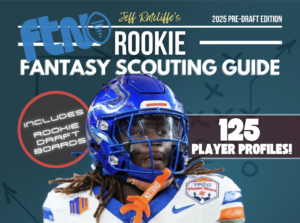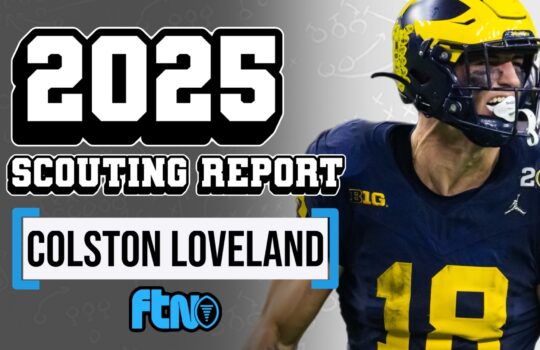
Every Monday, I find myself in a bit of NFL data purgatory. We’re waiting for the week to come to a proper ending, and the data is still yet to be finalized. It’s a great time, however, to look at some historical trends and do some digging on some things we can leverage in the upcoming week.
This piece will be out Tuesdays but won’t have the same format or topic each week. The formula will change as I poke around with the data we have access to here. It’ll just be my musings on something that caught my eye. If there’s something to it, I’ll give you some way to leverage the conclusions in fantasy for the upcoming week.
What did that announcer just say?
I wanted this piece to challenge conventional wisdom and one of these “football guy” sayings came out during the Giants broadcast Sunday. It was something along the lines of, “You can’t underestimate the value of a 1-yard run and how it wears down a defense.” It was first and 10. Now, on the one hand, I get it — there’s a physical element to football that I (and my spreadsheets) might never be able to comprehend. But as a community, we are absolutely, unequivocally positive that a 1-yard run on first and 10 does nothing to help your team.

“But Matt, don’t you see that spike in the positive section of the graph?” Yes, yes I do. But we’re looking at just over 8% of runs here with a positive EPA and it’s very situation specific. In fact, on average, a first and 10 has an expected point value of about 2.7 EP while a second and 9 drops to 1.8 EP.

With each subsequent down that passes, expected points go down when you’re not gaining yards. That’s not a life-altering realization, obviously, but it’s an important step in our process here. Side note: The first down line is a bit squirrelly because of some small samples of random yards to go after penalties.
You’re probably thinking that I spent way too much time cleaning data, making a graph, and writing about a stupid quote by an announcer just to show that expected points on a first and 10 are higher than on a second and 9. You’d be absolutely correct, but it’s a jumping-off point for some of the analysis I’ve been doing, so don’t bail on me just yet.
Do defenses ‘wear down’ from first-half runs?
There’s a lot to unpack there. The simplest way to look at this, though, is by comparing the relationship between first-half runs and how efficient runners are in the second half.

Do you see that nice, basically flat line? That’s our trend line. The trend line shows the relationship between the two variables on the plot. These two variables, number of first-half runs and second-half yards per carry, have no relationship with each other. Less than 2% of a team’s rushing efficiency in the second half can be explained by the number of rushes a team had in the first half. Maybe that isn’t fair, though. Games still remain pretty close in the third quarter often. Let’s see what happens when we compare the number of rushes from the first three quarters to fourth-quarter/OT rush efficiency.

Hmmm… So even 45 minutes of a rush-heavy attack doesn’t equate to higher efficiency. That could easily be explained by garbage time, right? Teams that are trying to milk the clock aren’t going to break off big runs, they’ll go down once they get the first down or sacrifice yards for ball security, right?

Nope. Still nothing there. Maybe there’s not a magic number of these early rushes that makes it happen, but the effects just happen slowly as the game goes on.

Wrong again. The fact of the matter is that this idea of teams “wearing down” opposing defenses with these rushes doesn’t jibe with reality. It’s a common trope across football to say that these effects exist. It just doesn’t jibe with intuition, though, because if the defense is getting physically punished on all of these plays, then the offense is also exerting energy throughout the game, as well.
Is it really that big of a deal when teams are hell bent on running?
Looking through the data, teams have a higher chance (73.5%) of getting another first down on a given series when they pass on first down compared to when they run on first down (70.8%). That’s not a huge gap on a per play basis, but small edges compound over time to add up over the course of a game or season.
In a given game, most teams will have somewhere between 8 and 12 offensive drives. If you’re giving up 3% of your chance at a successful series every time you run, you could be sacrificing 5-10 drives for the season. Given an average team in points per drive, that could be about 20 fewer points across the season. It doesn’t sound like a lot but these small edges and leaks compound over the course of the season.

First-down pass rate in these neutral situations explains about 23% of scoring. As you can see, there’s a fair number of outliers. The bottom-right quadrant here is a quartet of teams that are actually making the right decisions on first down and still have nothing to show for it. Of the 13 teams in the top-right quadrant, which is where you are seeing good decisions and the results to show for them, nine would be in the playoffs if they started today.

Key Takeaways
- The Jets/Giants/Jags are just incredibly awful in this metric. They’re leaving 5+ points on the board each game.
- The entire AFC West is bunched up -2 to +1 points over expectation.
- The Cowboys and Buccaneers are hovering around +7, which means they’re scoring an extra touchdown on average.
















































 New York Jets
New York Jets  New England Patriots
New England Patriots  Miami Dolphins
Miami Dolphins  Buffalo Bills
Buffalo Bills  Pittsburgh Steelers
Pittsburgh Steelers  Cleveland Browns
Cleveland Browns  Cincinnati Bengals
Cincinnati Bengals  Baltimore Ravens
Baltimore Ravens  Tennessee Titans
Tennessee Titans  Jacksonville Jaguars
Jacksonville Jaguars  Indianapolis Colts
Indianapolis Colts  Houston Texans
Houston Texans  Las Vegas Raiders
Las Vegas Raiders  Los Angeles Chargers
Los Angeles Chargers  Kansas City Chiefs
Kansas City Chiefs  Denver Broncos
Denver Broncos  Washington Commanders
Washington Commanders  Philadelphia Eagles
Philadelphia Eagles  New York Giants
New York Giants  Dallas Cowboys
Dallas Cowboys  Minnesota Vikings
Minnesota Vikings  Green Bay Packers
Green Bay Packers  Detroit Lions
Detroit Lions  Chicago Bears
Chicago Bears  Tampa Bay Buccaneers
Tampa Bay Buccaneers  New Orleans Saints
New Orleans Saints  Carolina Panthers
Carolina Panthers  Atlanta Falcons
Atlanta Falcons  San Francisco 49ers
San Francisco 49ers  Seattle Seahawks
Seattle Seahawks  Los Angeles Rams
Los Angeles Rams  Arizona Cardinals
Arizona Cardinals 










 Boston Celtics
Boston Celtics  Brooklyn Nets
Brooklyn Nets  Philadelphia 76ers
Philadelphia 76ers  New York Knicks
New York Knicks  Toronto Raptors
Toronto Raptors  Chicago Bulls
Chicago Bulls  Detroit Pistons
Detroit Pistons  Milwaukee Bucks
Milwaukee Bucks  Cleveland Cavaliers
Cleveland Cavaliers  Indiana Pacers
Indiana Pacers  Orlando Magic
Orlando Magic  Atlanta Hawks
Atlanta Hawks  Charlotte Hornets
Charlotte Hornets  Miami Heat
Miami Heat  Washington Wizards
Washington Wizards  Denver Nuggets
Denver Nuggets  Minnesota Timberwolves
Minnesota Timberwolves  Oklahoma City Thunder
Oklahoma City Thunder  Portland Trail Blazers
Portland Trail Blazers  Utah Jazz
Utah Jazz  LA Clippers
LA Clippers  Golden State Warriors
Golden State Warriors  Los Angeles Lakers
Los Angeles Lakers  Phoenix Suns
Phoenix Suns  Sacramento Kings
Sacramento Kings  Dallas Mavericks
Dallas Mavericks  Houston Rockets
Houston Rockets  Memphis Grizzlies
Memphis Grizzlies  New Orleans Pelicans
New Orleans Pelicans  San Antonio Spurs
San Antonio Spurs 









